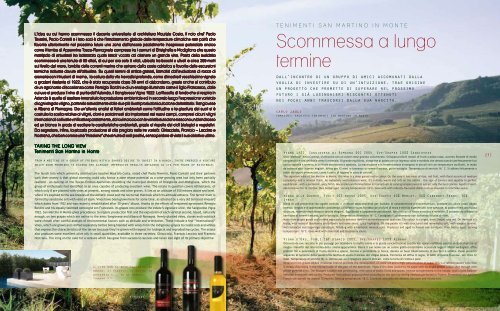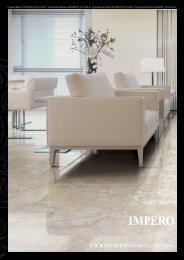You also want an ePaper? Increase the reach of your titles
YUMPU automatically turns print PDFs into web optimized ePapers that Google loves.
[22<br />
L’idea su cui hanno scommesso il docente universitario <strong>di</strong> architettura Maurizio Costa, il noto chef Paolo<br />
Teverini, Paolo Cantelli e i loro soci è che l’innalzamento globale delle temperature climatiche non potrà che<br />
favorire ulteriormente nel prossimo futuro una zona dall’ancora parzialmente inespresso potenziale enoico<br />
come il lembo <strong>di</strong> Appennino Tosco-Romagnolo compreso tra i comuni <strong>di</strong> Brisighella e Mo<strong>di</strong>gliana che questo<br />
manipolo <strong>di</strong> entusiasti ha battezzato quale terroir vocato ad ottenere un grande vino. Posta della suddetta<br />
scommessa è una tenuta <strong>di</strong> 60 ettari, <strong>di</strong> cui per ora solo 8 vitati, ubicata tra boschi e uliveti a circa 350 metri<br />
sul livello del mare, lambita delle correnti marine che spirano dalla costa adriatica e favorita delle escursioni<br />
termiche notturne dovute all’altitu<strong>di</strong>ne. Su questi terreni <strong>di</strong> antica genesi, formatisi dall’evoluzione <strong>di</strong> rocce <strong>di</strong><br />
arenaria con intrusioni <strong>di</strong> marne, la coltura della vite ha ra<strong>di</strong>ci profonde, come <strong>di</strong>mostra il vecchissimo vigneto<br />
a gradoni risalente al 1922, che è stato recuperato dopo 30 anni <strong>di</strong> abbandono, grazie anche al contributo<br />
<strong>di</strong> un agronomo d’eccellenza come Remigio Bor<strong>di</strong>ni e <strong>di</strong> un enologo illuminato come il figlio Francesco, dalle<br />
cui uve si produce il vino <strong>di</strong> punta dell’Azienda, il Sangiovese Vigna 1922. La filosofia <strong>di</strong> fondo che si respira in<br />
Azienda è quella <strong>di</strong> esaltare innanzitutto la produzione ambientale ed in secondo luogo l’espressione varietale<br />
<strong>di</strong> ogni singolo vitigno, partendo naturalmente dalle due più illustri produzioni autoctone del territorio: Sangiovese<br />
e Albana <strong>di</strong> <strong>Romagna</strong>. Da un’attenta analisi <strong>di</strong> fattori ambientali come l’altitu<strong>di</strong>ne e la giacitura dei suoli si è<br />
costruita la scelta relativa ai vitigni, cloni e portainnesti da impiantarsi nei nuovi campi, compresi alcuni vitigni<br />
internazionali coltivati e vinificati separatamente, dal cui incrocio con le varietà autoctone nascono un blend rosso<br />
ed un bianco in grado <strong>di</strong> esaltare le caratteristiche ambientali, grazie al rispetto dei cicli biologici e vegetativi.<br />
Da segnalare, infine, la piccola produzione <strong>di</strong> olio pregiato nelle tre varietà: Ghiacciola, Frantoio – Leccino e<br />
Nostrana, che ben corona una “missione” che si nutre <strong>di</strong> esiti positivi, senza perdere <strong>di</strong> vista il suo obiettivo ultimo.<br />
TAKING THE LONG VIEw<br />
Tenimenti San Martino in Monte<br />
From a meeting of a group of friends with a shared desire to invest in a hunch, there emerged a venture<br />
which soon promises to exceed the already impressive results obtained in its few years of existence.<br />
The hunch into which university architecture teacher Maurizio Costa, noted chef Paolo Teverini, Paolo Cantelli and their partners<br />
sunk their money is that global warming could only favour a zone whose potential as a wine-growing area had only been partially<br />
realized – an outcrop of the Tuscan-Emilian Apennines straddling the municipal <strong>di</strong>stricts of Brisighella and Mo<strong>di</strong>gliana, which the<br />
group of enthusiasts had identified as an area capable of producing excellent wine. The estate in question covers 60 hectares, of<br />
which only 8 are planted with vines at present, among woods and olive groves. It lies at an altitude of 350 metres above sea level,<br />
where it’s exposed to the sea breezes of the Adriatic coast and the nocturnal thermals which its altitude attracts. The terroir itself is<br />
formed by sandstone soil with veins of loam. Vines have been grown here for some time, as attested by a very old terraced vineyard<br />
which dates from 1922 and was recently rehabilitated after 30 years’ <strong>di</strong>suse, thanks to the efforts of renowned agronomist Remigio<br />
Bor<strong>di</strong>ni and his equally talented oenologist son Francesco. Its grapes now produce the estate’s signature wine, the Sangiovese Vigna<br />
1922. San Martino in Monte gives precedence to organic production first and the expression of each varietal second, based, naturally<br />
enough, on two grapes which are native to the area: Sangiovese and Albana <strong>di</strong> <strong>Romagna</strong>. Newly-planted vines, clones and rootstock<br />
were chosen after careful analysis of environmental factors such as altitude and orientation. These include a few “international”<br />
vines, which are grown and vinified separately before being blended with wines from the in<strong>di</strong>genous grapes to create reds and whites<br />
that express the characteristics of the terroir because they’re grown with respect for biological and reproductive cycles. The estate<br />
also produces some excellent olive oils in small quantities, available in three varieties: Ghiacciola, Frantoio Leccino and Frantoio<br />
Nostrana. The icing on the cake for a venture which has gone from success success to success success and never never lost sight of its its primary objective.<br />
Il vino non si beve soltanto, si<br />
annusa, si osserva, si gusta, si<br />
sorseggia e... se ne parla.<br />
Edoardo VII<br />
I Sensi <strong>di</strong> <strong>Romagna</strong><br />
T ENIMENTI S AN M ARTINO IN M ONTE<br />
Scommessa a lungo<br />
termine<br />
dall’incontro <strong>di</strong> un gruppo <strong>di</strong> amici accomunati dalla<br />
voglia <strong>di</strong> investire su <strong>di</strong> un’intuizione, trae origine<br />
un progetto che promette <strong>di</strong> superare nel prossimo<br />
futuro i già lusinghieri riscontri ottenuti<br />
nei pochi anni trascorsi dalla sua nascita.<br />
carlo zauli<br />
immagini: archivio tenimenti san martino in monte<br />
Vigna 1922_ Sangiovese <strong>di</strong> <strong>Romagna</strong> DOC 2004_ Uve/Grapes 100% Sangiovese<br />
Vino “simbolo” della Cantina, si annuncia con un colore rosso granato concentrato. Sviluppa profumi maturi <strong>di</strong> frutti a polpa rossa, accento floreale <strong>di</strong> me<strong>di</strong>a<br />
complessità e vira nel finale verso il minerale. Di grande equilibrio, si esprime al palato con un ingresso caldo e morbido che denota tannini perfettamente fusi<br />
con la sapi<strong>di</strong>tà e termina in un finale persistente e speziato. La macerazione e la fermentazione avvengono in piccoli tini con temperature oscillanti, in modo<br />
da estrarre solo i tannini migliori. Affina per 12 mesi in tonneaux <strong>di</strong> rovere francese, poi in bottiglia. Temperatura <strong>di</strong> servizio 16° C. Si abbina felicemente a<br />
piatti dai sapori pronunciati, come il petto <strong>di</strong> fagiano in salsa <strong>di</strong> carciofi.<br />
The signature wine of San Martino in Monte, this wine is a deep garnet-red in colour. On the nose it has notes of ripe, red fruit, with floral accents of me<strong>di</strong>um<br />
complexity and a mineral finish. An extremely well-balanced wine, it’s initially warm and soft on the palate - the sign of tannins and sapi<strong>di</strong>ty in perfect<br />
equilibrium – with a persistent, spicy finish. Maceration and fermentation is in small vats at varying temperatures to extract only the best tannins. Aged in French<br />
oak tonneaux for 12 months, then bottle aged. Serving temperature: 16°C. Goes well with robustly-flavoured <strong>di</strong>shes such as pheasant in artichoke sauce.<br />
Vigna alle Querce_ Forlì IGT rosso 2005_ Uve/Grapes 40% Merlot, 30% Cabernet Franc, 30%<br />
Syrah<br />
Blend <strong>di</strong> uve provenienti da vigneti coltivati e vinificati separatamente per esaltare le caratteristiche mirco-ambientali, possiede un colore rosso rubino<br />
intenso, limpido e <strong>di</strong> apprezzabile consistenza. All’olfatto risulta fruttato con profumi <strong>di</strong> mora e mirtillo e penetranti note speziate. Al palato rivela una buona<br />
struttura, notevole morbidezza e tannini eleganti. Equilibrato e lungamente persistente, termina con un finale armonico e minerale. È prodotto ed affinato in<br />
barriques <strong>di</strong> rovere francese, poi in bottiglia. Temperatura <strong>di</strong> servizio 18° C. Consigliato l’abbinamento con sottofesa in salsa <strong>di</strong> ribes.<br />
Made from grapes grown and vinified separately to enhance their micro-environmental qualities. The colour is a bright, even, limpid ruby red. On the nose it’s<br />
fruity, with notes of blackberry and bilberry and some sharp, spicy highlights. On the palate it’s well-structured and remarkably soft, with elegant tannins.<br />
Well-balanced and lingeringly persistent, finishing with a harmonic mineral note. Produced and aged in French oak barriques, then bottle aged. Serving<br />
temperature: 18°C. Goes well with silverside and blackberry sauce.<br />
Vigna d’Oro_ Forlì IGT bianco 2005_ Uve/Grapes 100% Albana<br />
Ottenuto da uve raccolte in più passaggi per attendere la muffa nobile e la giusta concentrazione zuccherina, questo raffinato passito sembra sfruttare al<br />
meglio i benefici del microclima della catena appenninica. Onora il suo nome con un colore giallo oro brillante acceso da leggeri riflessi verdognoli, offre<br />
profumi fini e penetranti <strong>di</strong> frutta esotica e spezie. Intenso e persistente in bocca, denota un buon bilanciamento <strong>di</strong> zuccheri e aci<strong>di</strong>tà. Viene prodotto<br />
seguendo le tecniche della vendemmia tar<strong>di</strong>va <strong>di</strong> scuola francese del vitigno Albana. Fermenta ed affina in legno, in botti <strong>di</strong> rovere francese, per circa 12<br />
mesi. Temperatura <strong>di</strong> servizio 18° C. Ottimo per accompagnare dessert delicati, come la torta <strong>di</strong> ricotta e pere.<br />
Obtained from grapes picked in several tries to promote the development of noble rot and a high concentration of sugar, this is a refined passito wine that<br />
is clearly flourishing in the microclimate of this part of the Apennines. Vigna d’Oro does justice to its name with its bright golden colour shot through with<br />
gentle greenish tints. The bouquet is subtle and penetrating, with notes of exotic fruits and spices. Intense and persistent in the mouth, with a good balance<br />
between sweetness and aci<strong>di</strong>ty. Produced from Albana grapes picked accor<strong>di</strong>ng to the late harvesting methods perfected in France. Fermented and aged in<br />
French oak barrels for around 12 months. Serving temperature: 18°C. Excellent with delicate desserts like pear and ricotta tart.<br />
Enogastronomia<br />
23]
















